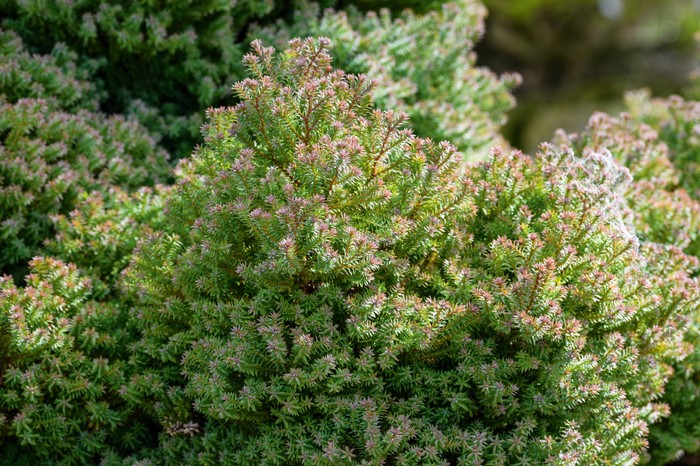
The best small conifers to grow
For many, the word conifer conjures an image of imposing trees and hedges, but there are also smaller types that can add useful evergreen structure. Matthew Pottage, Curator at RHS Garden Wisley, recommends some of the best to grow. Photographs by Jason Ingram.
For many, the word conifer conjures an image of a large tree or tall hedge, but there are lots of slower growing, small and dwarf conifers that are ideal for modern gardens. Many can even be grown in containers.
Small conifers can form attractive shapes, including cushions and mounds, or become small, manageable small trees. Some have colourful foliage, or foliage that changes colour in winter. Miniature cones and attractive bark add to their appeal. Some small conifers are excellent for clipping into shapes, and even cloud pruning.
Perhaps driven by the pest and disease issues affecting box (Buxus) recently, including box blight and box tree caterpillar, there’s been a sharp focus on small-leaved evergreen conifers, including pines, spruce, Podocarpus, cypress (Cryptomeria) and Chamaecyparis. Mountain pines, Pinus mugo, have been used to great effect as evergreen mounds by designers Chris Beardshaw and Matt Keightley at the RHS Chelsea Flower Show in recent years.
Podocarpus is probably my number one box alternative. It can take close clipping, doesn’t grow too fast and, usefully, regenerates from old wood.
In winter, many conifers are a wonderful foil for winter-flowering plants, plants with winter seedheads, or the buff-gold of dormant ornamental grasses. Shade-loving conifers work well with ferns, epimediums and other woodland shade plants.
What A range of small and slow-growing conifers offering a range of foliage textures, colours and interesting bark.
Origins Conifers are widespread across temperate and tropical climates, in both northern and southern hemispheres.
Season Conifers come into their own in winter when the all-important structure and ‘bones’ of a garden come into play. Cultivars that change colour in colder weather also show their merit.
Size The heights provided are an average after ten years. Over that period these conifers vary from around 30cm to 1.5m, depending on conditions.
Conditions Most conifers give better foliage colour in good light levels. Cryptomeria and Podocarpus will tolerate shade.
Hardiness All the conifers featured are reliably hardy across UK gardens. The exception is perhaps Podocarpus, which is only hardy down to -18°C.
Small conifers: how to grow

Where to plant conifers
Most conifers grow best in a bright, sunny spot.
Chamaecyparis generally prefer full sun. They show their most glamorous foliage habit in good light levels, and do not like their feet sitting in water.
Most pines prefer full sun, and well-drained soil. Those that turn a golden colour in cold weather will give the most vibrant display in full sun. The exceptions to this rule are those with variegated needles, such as Pinus parviflora ‘Fukai’, which may suffer some sunburn on heavily banded needles. For these, a position away from the blazing midday sun would be beneficial.
Cryptomerias and Podocarpus can tolerate shade, and even some winter wet.
How to care for conifers
Conifers are remarkably easy plants to please. They should be kept watered through the first couple of summers if conditions are dry, but once established, rarely need additional irrigation.
Pruning small conifers
Conifers do not need regular pruning, but you can prune them to shape them or to control their size. Conifers are easy to prune by trimming or removing new growths, sometimes known as ‘candles’, in spring. These new shoots, which appear in the terminal growing points, often have a clear central leader that can be shortened with a sharp pair of scissors, or simply plucked out with index finger and thumb.
For a more vigorous prune, use secateurs to shorten the previous two- to-three seasons’ growth back down to a whorl of branches. You should, however, avoid pruning too severely – this never ends well. Many conifers do not regenerate from old wood and the pruning cuts will gaze back at you for years to come.
How to propagate conifers
Pines are best propagated by grafting, as the cultivars will not come true from seed. A grafted pine will cost more than an average shrub or perennial.
Chamaecyparis can be propagated by cuttings, most commonly through semi- ripe cuttings, with some gentle bottom heat, ensuring they do not dry out. I’ve had more success with heel cuttings, taken in winter, planted into a pan and popped into a cold frame somewhere cool, outdoors, where they sit, seemingly doing nothing, until roots sprout from the base of the pot.
Both Cryptomeria and Podocarpus root from semi-ripe tip cuttings, taken in late summer. Podocarps are the easiest of all to root – useful if you are planning to replace extensive box hedging.
The best small conifers to grow
Picea pungens Glauca Group ‘Glauca Globosa’

Its wonderful, ice-blue needle colour makes this spruce a real stand out in the border. At RHS Garden Wisley, we have used it with wine-red maples, purple pittosporum and grey corokia. Height: 60-70cm. AGM. RHS H7, USDA 2a-7b.
Chamaecyparis obtusa ‘Nana Gracilis’

A fascinating plant with deep- green foliage that appears in small, fan-like arrangements to create an extremely elegant talking point. Can be left to form a bubbly looking mound, or, in older age (the example shown here is nearly 100 years old), effectively cloud pruned. Height: 1.5m. AGM. RHS H7, USDA 4a-8b.

Pinus mugo ‘Winter Gold’
A low, slow-growing cultivar that produces mini cones, and flushes yellow in cold weather. It slowly reverts to green as the temperatures rise again in spring. Can be easily shaped by candle pruning (see page 57) in spring. Height: 1-1.5m. AGM.
RHS H7, USDA 2a-7b.
Cryptomeria japonica ‘Little Sonja’

Useful in both sun and shade, this is a tangled, textural feast for the eyes. Its fresh green, almost succulent-like, stems have flattened green leaves that are arranged close to the stem. Height: 50-60cm. RHS H6, USDA 5a-8b.
Pinus strobus ‘Sea Urchin’

A photogenic and fluffy, bun-like pine, which over time creates a fuzzy mound with soft, delicate needles. Happiest in full sun to very light shade, it looks good in an elegant pot or urn. A personal favourite. Height: 40-60cm. RHS H5, USDA 3a-8b.
Pinus strobus ‘Green Twist’

A cultivar that almost has to be seen to be believed. Its small needles are twisted, allowing the white undersides of the needles to be shown off, creating a wonderful foliage effect. Height: 40-50cm. RHS H6, USDA 3a-8b.
Pinus mugo

This is the typical and very dense, compact mountain pine. Excellent cold tolerance and easy to shape. Good for evergreen structure, and can look elegant in a pot. Known for their cold tolerance, these mountain pines seldom grow with any apical dominance, so plants growing wider than tall is not uncommon. Height: 30-50cm. RHS H7, USDA 2a-7b.
Chamaecyparis thyoides ‘Rubicon’

A cultivar that flushes purple-plum in winter and turquoise green in summer. Grows naturally as a mini cloud-pruned tree without any assistance. Best grown in full sun. Height: 30-50cm. RHS H6, USDA 4a-8b.
Pinus contorta ‘Chief Joseph’

A vibrant, zingy, golden yellow in winter, it reverts to green in summer. Best grown in full sun, this cultivar can make a small tree in time, but is very slow growing. Height: 70-90cm. AGM. RHS H6, USDA 4a-8b.
Pinus parviflora ‘Fukai’

A personal favourite, with variegated needles and colourful pollen cones, set off by smooth, silvery grey bark. The growth habit resembles a giant bonsai, and at Wisley it always stops people in their tracks so they can take a closer look. Height: 1-1.5m.
Podocarpus nivalis

Podocarpus is probably my number one box alternative. It can take close clipping, doesn’t grow too fast and, usefully, regenerates from old wood. The muted green foliage of Podocarpus nivalis is a good foil for other plants. It doesn’t go bald in the shade, and can straddle the line between sun and shade. Growth is slow, so an annual clip can keep it in bounds. Height: 1-1.2m. RHS H5.
Podocarpus ‘Guardsman’

A hybrid podocarp that turns a deep burgundy- red in winter, before putting on a flaming red show in spring, then deep green in summer. Able to perform in both sun and shade, and tolerant of close clipping. Height: 1-1.4m. RHS H5.
Podocarpus ‘Young Rusty’

In winter to late spring, the deep-green foliage of Podocarpus 'Young Rusty' is flushed a deep red-bronze, after which colourful new shoots appear. Brilliant in sun or shade, and able to withstand clipping, it can regenerate from old wood. Height: 1-1.3m. RHS H5.
Where to buy and see small conifers
RHS Garden Wisley
Wisley Lane, Wisley, Woking, Surrey GU23 6QB. Tel 01483 224234, www.rhs.org.uk/gardens/wisley
Ashwood Nurseries
Ashwood Lower Lane, Kinver, Kingswinford, West Midlands DY6 0AE. Tel 01384 401996, www. ashwoodnurseries.com Home also to John Massey’s own garden, a great source of inspiration.
The Bressingham Gardens
Low Road, Diss, Norfolk IP22 2AA
Tel 07300 100445, www.thebressinghamgardens.com
Home to Adrian Bloom’s garden, Foggy Bottom, which is an inspirational place to see creative pruning and shaping.
Larch Cottage Nurseries
Melkinthorpe, Penrith, Cumbria CA10 2DR. Tel 01931712404, www.larchcottage.co.uk
Lime Cross Nursery
Herstmonceux, Hailsham, East Sussex BN27 4RS. Tel01323833229, www.limecross.co.uk
Authors
Matthew Pottage is curator of the Royal Horticultural Society's Wisley gardens.
Jason Ingram is an award winning garden photographer based in Bristol, UK. He travels widely shooting for magazines, book publishers and advertising agencies. He also works with top international garden designers and Landscape Architects on private projects worldwide.

Niwaki bundle worth £57 when you subscribe
Subscribe to Gardens Illustrated magazine and claim your Niwaki bundle worth £57
*UK only

Container Gardening Special Edition
The Gardens Illustrated Guide to Container Gardening.
In this special edition, discover colourful flower combinations and seasonal planting schemes for pots designed by leading plantspeople, and essential know-how for container gardening success. Just £9.99 inc UK p&pBy entering your details, you are agreeing to our terms and conditions and privacy policy. You can unsubscribe at any time.

Gardens of the Globe
From botanical wonders in Australia to tranquil havens closer to home in Ireland, let this guide help you to discover some of the most glorious gardens around the world
By entering your details, you are agreeing to our terms and conditions and privacy policy. You can unsubscribe at any time.





